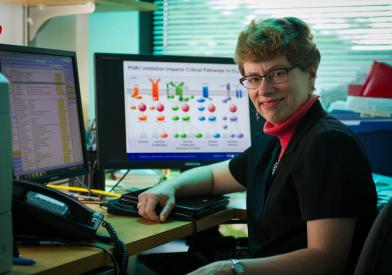What Is Chronic Lymphocytic Leukemia?
Chronic lymphocytic leukemia (CLL) is a type of cancer in which the bone marrow makes too many lymphocytes (a type of white blood cell).
Leukemia may affect red blood cells, white blood cells, and platelets.
Normally, the body makes blood stem cells (immature cells) that become mature blood cells over time. A blood stem cell may become a myeloid stem cell or a lymphoid stem cell.
A myeloid stem cell becomes one of three types of mature blood cells:
- Red blood cells that carry oxygen and other substances to all tissues of the body
- White blood cells that fight infection and disease
- Platelets that form blood clots to stop bleeding
A lymphoid stem cell becomes a lymphoblast cell and then one of three types of lymphocytes (white blood cells):
- B lymphocytes that make antibodies to help fight infection
- T lymphocytes that help B lymphocytes make antibodies to fight infection
- Natural killer cells that attack cancer cells and viruses
In CLL, too many blood stem cells become abnormal B lymphocytes and do not become healthy white blood cells. The abnormal lymphocytes may also be called leukemia cells. The lymphocytes are not able to fight infection very well. Also, as the number of lymphocytes increases in the blood and bone marrow, there is less room for healthy white blood cells, red blood cells, and platelets. This may cause infection, anemia, and easy bleeding.
How Common is CLL?
CLL is one of the most common types of leukemia in adults. The average age of diagnosis is when people are in their late 60s.
What are the Risk Factors for CLL?
Most patients don't have a specific risk factor for CLL. Some characteristics that may be associated with CLL include:
- Being elderly, male, or white
- A family history of CLL or cancer of the lymph system
- Exposure to Agent Orange
What are the Symptoms and Signs of CLL?
Many people do not have any symptoms when they are diagnosed. CLL is often found when a doctor orders blood tests for an unrelated health problem.
Symptoms can include:
- Weakness
- Feeling tired
- Unintentional weight loss
- Night sweats
- Enlarged lymph nodes (often felt as lumps under the skin)
- Pain or a sense of "fullness" in the belly (this can make someone feel full after only a small meal), which is caused by an enlarged spleen and/or liver
- Inability to fight serious infections well
Growth and Spread
CLL is a chronic (ongoing) disease that usually gets worse slowly. It often is present in the bone marrow, blood, and lymph nodes, and more rarely in organs.
Precursor Conditions for CLL
CLL is often preceded by a precursor condition, which is an early precancerous phase of blood diseases that may develop into cancer. Monoclonal B-cell lymphocytosis (MBL) is the common precursor condition to CLL. Most people who develop CLL have had MBL, and about 1 percent per year will convert to CLL.
Our researchers in the Center for Early Detection and Interception of Blood Cancers (formerly the Center for Prevention of Progression) are studying the genomic, genetic, and epigenetic factors that characterize conditions that are often "precancerous." We aim to understand what changes cause MBL to progress to CLL so that we can prevent progression in the future.
This research is driven by the center's PCROWD study, which collects, processes, and stores tissue samples from people with precursor conditions from across the United States.
Find a list of drugs approved for chronic lymphocytic leukemia.


566x487.jpg?crop=yes&k=c&w=392&h=275&itok=CTlZpBwj)


